RNA Structure
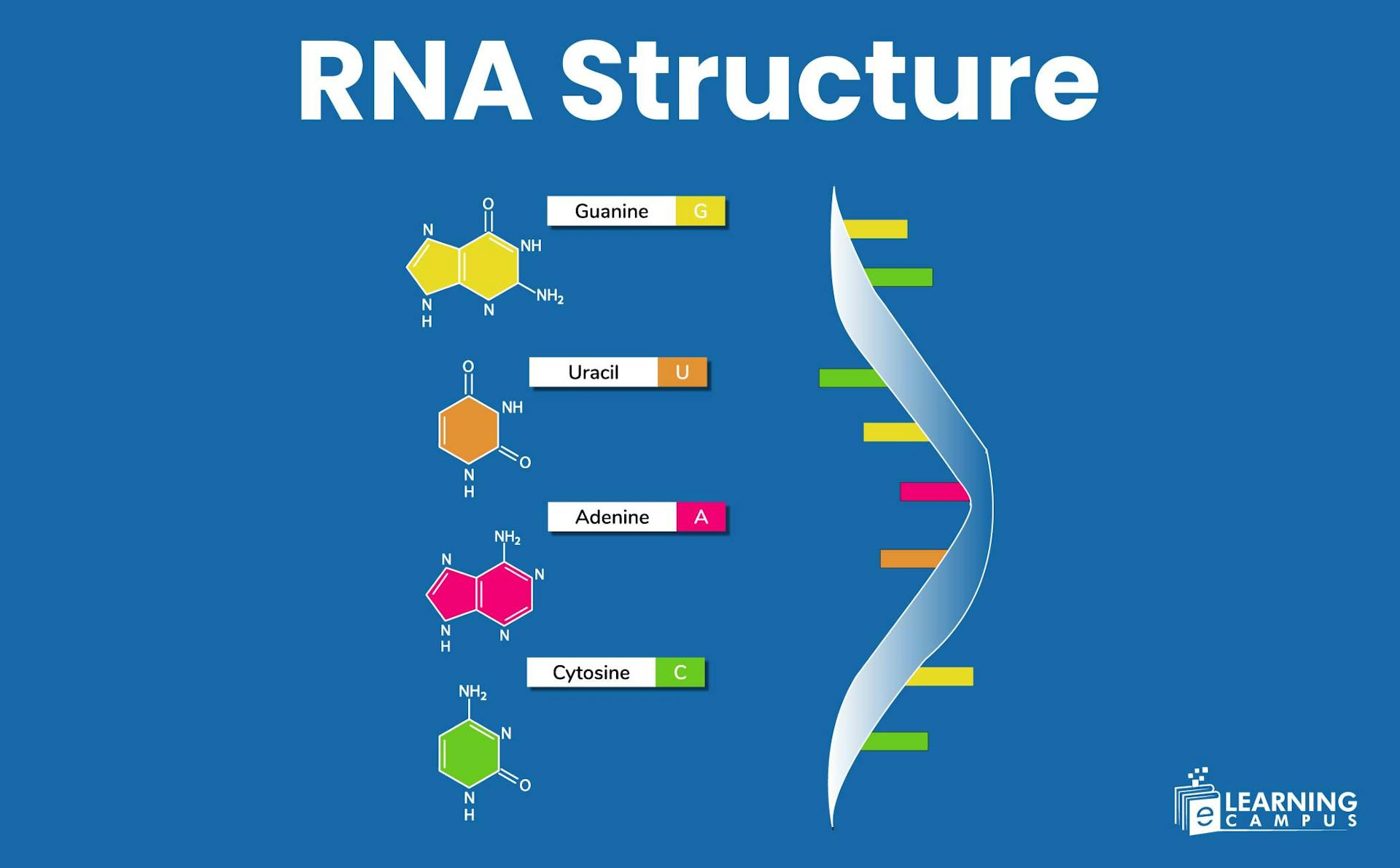
We know DNA as the master blueprint of life, the double helix holding our genetic code. But what if the cell's most versatile and dynamic architect is not DNA, but its single-stranded cousin, RNA?
RNA is a single-stranded polymer of ribonucleotides, each composed of a ribose sugar, a phosphate group, and one of four bases (adenine, guanine, cytosine, or uracil)
In this blog, we will unravel the RNA structure, exploring how its unique forms enable it to perform roles that are essential for life.
What is the RNA
Ribonucleic acid or RNA is a single-stranded biomolecule that plays an important role in several biological processes, such as protein synthesis, cellular communication, and gene regulation.
It is made of nucleotides. Each nucleotide is composed of a backbone of alternating ribose sugars and phosphate groups, with nitrogenous bases adenine (A), guanine (G), cytosine (C), and uracil (U) attached to the sugar.
What Are the Functions of RNA
RNA has an important function in protein synthesis. It acts as the intermediary for protein synthesis by carrying genetic instructions from DNA to ribosomes (mRNA).
It delivers amino acids to the ribosome for assembly (tRNA) and forms the core structure and catalytic component of ribosomes (rRNA).
Functions of RNA in Protein Synthesis
The three main types of RNA play their role in protein synthesis. These RNAs work together in a process called translation to create proteins to synthesize the protein.
The RNAs involved in the making of proteins are;
- Messenger RNA (mRNA): This RNA carries the genetic blueprint from the DNA in the cell's nucleus to the ribosomes.
- Transfer RNA (tRNA): This RNA picks up specific amino acids and brings them to the ribosome. They ensure that the correct amino acids are added to the growing protein chain.
- Ribosomal RNA (rRNA): The Ribosomal RNA forms the structural backbone of the ribosome. It helps catalyze the formation of peptide bonds between amino acids and links them into a protein.
Functions of Noncoding RNA
Noncoding RNAs (ncRNAs) are RNA molecules that are transcribed from DNA but not translated into proteins. They play critical roles in several biological processes.
- Gene Regulation: ncRNAs can regulate gene expression at both the transcriptional and post-transcriptional levels.
- Genome Protection: They help safeguard the genome. For example, they prevent the activity of transposable elements.
- Biological Processes: ncRNAs are integral to fundamental processes such as cell differentiation, metabolism, and response to various environmental stresses.
- Ligands and signaling: Some ncRNAs can act as ligands, binding to proteins to induce conformational changes that trigger downstream signaling events.
Structure of RNA
RNA (ribonucleic acid) is a single-stranded nucleic acid. Its structure can be explained at multiple levels, i.e, chemical composition, primary, secondary, and tertiary structures.
RNA structure represents its unique three-dimensional folding that arises from base-pairing and influences its diverse biological functions. It shows how it acts as a template for protein synthesis, carrying genetic information, and regulating gene expression.
Chemical Composition of RNA
At the molecular level, RNA is a polymer made of nucleotides. Each nucleotide consists of three components:
- Sugar: Ribose, a five-carbon sugar with a hydroxyl (-OH) group on the 2' carbon. It distinguishes it from DNA’s deoxyribose.
- Phosphate Group: The phosphate group links adjacent nucleotides through phosphodiester bonds, forming the backbone.
- Nitrogenous Base: One of four nitrogen bases attaches to sugar. The nitrogen bases are Purines that include Adenine (A), Guanine (G), and Pyrimidines, which include Cytosine (C) and uracil (U). In DNA, there is thymine instead of uracil.
The nucleotides are linked by phosphodiester bonds between the 5’ phosphate of one nucleotide and the 3’ hydroxyl of the next, creating a sugar-phosphate backbone with a 5’ to 3’ directionality.
Below is the illustration of the RNA structure diagram.
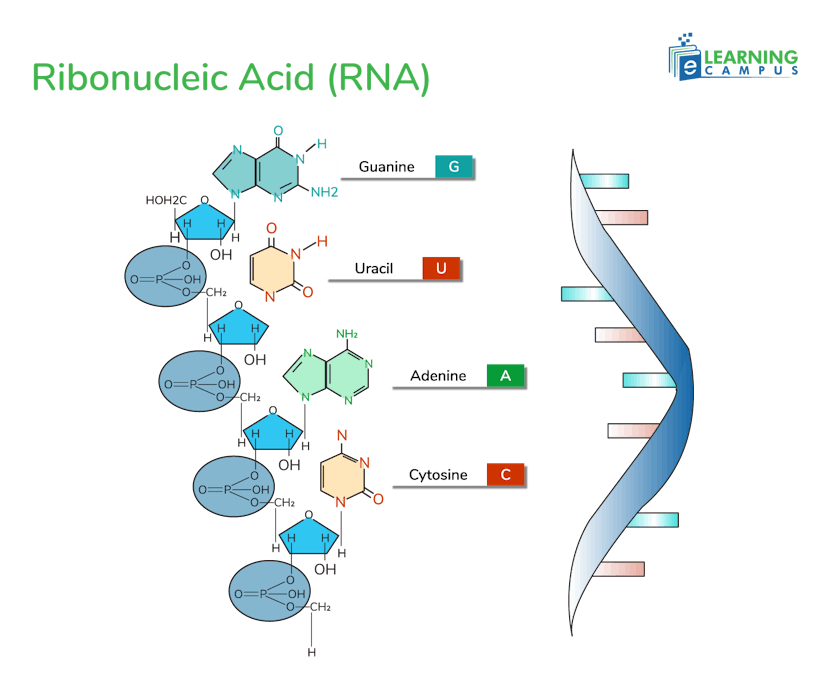
Primary Structure of RNA
The primary structure of RNA is the linear sequence of nucleotides. These nucleotides are linked together by 5'-3' phosphodiester bonds to form a single-stranded polymer.
This sequence determines the RNA’s function. It encodes genetic information and facilitates specific interactions in processes like translation.
In simpler terms, the primary structure is like a string of beads, where each bead is a nucleotide, and the specific sequence of these beads determines the function of RNA.
Secondary Structure of RNA
RNA secondary structure refers to the base-pairing interactions within a single RNA molecule. The single strand can fold back on itself, forming double-stranded regions through complementary base pairing:
- Adenine (A) pairs with Uracil (U) via two hydrogen bonds.
- Guanine (G) pairs with Cytosine (C) via three hydrogen bonds.
Common secondary structures include:
- Hairpin Loops: The strand folds back, forming a double-stranded stem (base-paired region) and a single-stranded loop
- Bulges: Unpaired bases in one strand of a double-stranded region.
- Internal Loops: Unpaired bases on both strands in a double-stranded region.
- Multiloops: Junctions where multiple stems meet.
These structures are stabilized by hydrogen bonds and base-stacking interactions, which contribute to the molecule’s stability.
Tertiary Structure of RNA
The secondary structures further fold into a three-dimensional tertiary structure, driven by:
- Hydrogen Bonds: Additional non-canonical base pairing (e.g., Hoogsteen pairs).
- Hydrophobic Interactions: Base stacking compacts the molecule.
- Ionic Interactions: Magnesium ions (Mg²⁺) stabilize negatively charged phosphate groups.
- Pseudoknots: A loop region pairs with a complementary sequence outside the loop, creating complex folds.
The tertiary structure determines the RNA’s functional shape, critical for its role (e.g., tRNA’s L-shaped structure for translation).
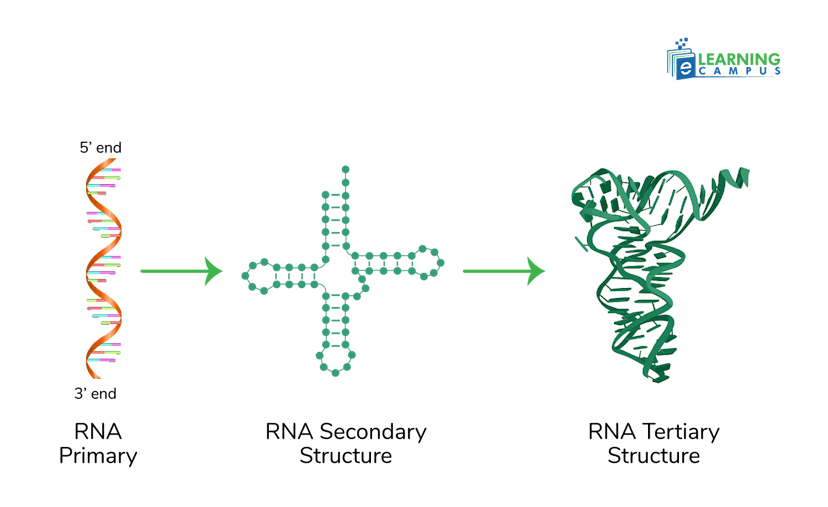
Looking to learn Biology concepts online? Get help from an expert science tutor.
How RNA is Synthesized
RNA is synthesized by a process called transcription. In this process, the genetic information in DNA is copied into a complementary RNA molecule. It occurs in three main stages: initiation, elongation, and termination.
Below is the explanation of each step in detail to clarify how RNA synthesis works.
Initiation
Initiation is the starting point of transcription. In this stage, RNA polymerase, the enzyme responsible for synthesizing RNA, binds to a specific region of the DNA called the promoter. The promoter is a unique DNA sequence that signals the beginning of a gene and acts like a ‘start here’ sign.
- In eukaryotes, transcription factors (proteins) help RNA polymerase locate and bind to the promoter.
- Once bound, RNA polymerase unwinds and separates the two strands of the DNA double helix. This process creates a small transcription bubble.
- This exposes the DNA’s genetic code (the template strand) for reading.
- The template strand (also called the antisense strand) is the one used to guide RNA synthesis, while the other strand (coding strand) remains unused but has a sequence similar to the RNA produced.
Initiation ensures that transcription begins at the correct location on the DNA, setting the stage for accurate RNA synthesis.
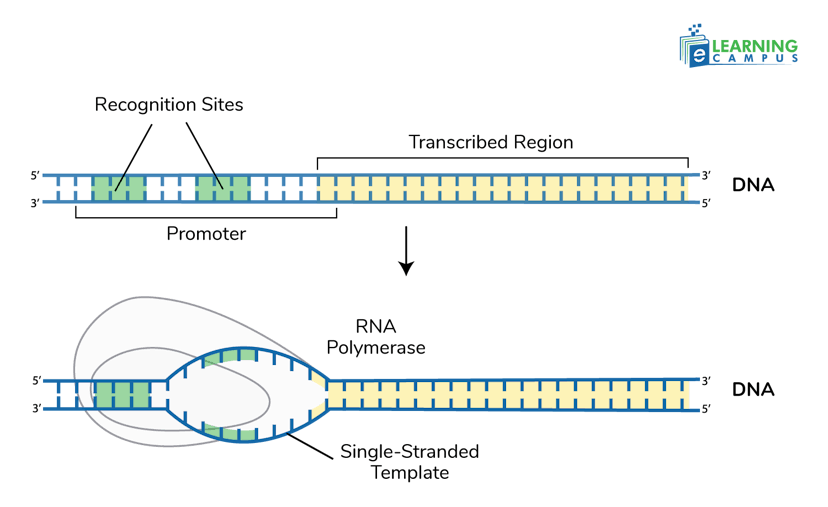
Elongation
Elongation is the second stage in RNA synthesis. RNA polymerase moves along the DNA template strand. It reads it in the 3' to 5' direction (from the 3' end to the 5' end of the DNA).
As it moves, it builds a single-stranded RNA molecule by adding ribonucleotides (the building blocks of RNA) that are complementary to the DNA template.
- Adenine (A) on the DNA template pairs with uracil (U) in RNA (unlike DNA, where A pairs with T).
- Thymine (T) on the DNA template pairs with adenine (A) in RNA.
- Cytosine (C) on the DNA template pairs with guanine (G) in RNA
- Guanine (G) on the DNA template pairs with cytosine (C) in RNA.
- The RNA strand grows in the 5' to 3' direction, meaning new nucleotides are added to the 3' end of the growing RNA chain.
- As RNA polymerase progresses, the DNA behind it rewinds back into its double-helix structure, while the transcription bubble moves forward.
Elongation is the phase where the actual RNA molecule is synthesized, accurately copying the genetic information from the DNA template.
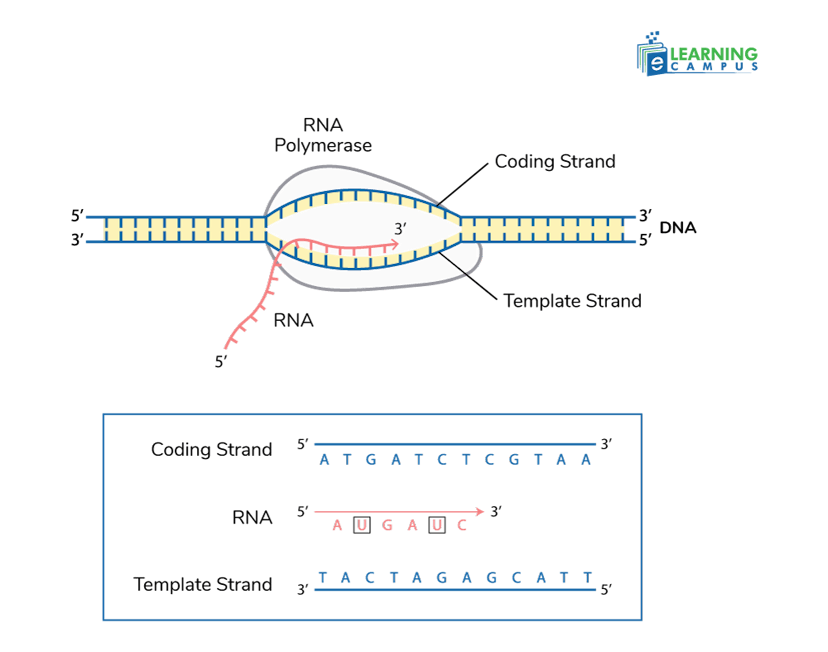
Termination
Termination is the final stage of transcription. It ends when RNA polymerase reaches a specific DNA sequence called the terminator. This sequence signals the enzyme to stop adding nucleotides and release the newly formed RNA molecule.
In prokaryotes, termination can occur in two ways:
- Rho-independent termination: The RNA forms a hairpin loop (due to complementary base pairing within the RNA sequence), causing the polymerase to pause and detach.
- Rho-dependent termination: A protein called Rho binds to the RNA and pulls it away from the polymerase, halting transcription.
In eukaryotic cells, termination is more complex and often involves additional proteins and processing steps, such as adding a poly-A tail to the RNA.
After termination, the RNA polymerase detaches from the DNA, and the DNA double helix fully reforms.
Termination ensures that transcription stops at the correct point, preventing the synthesis of unnecessary or incorrect RNA sequences.
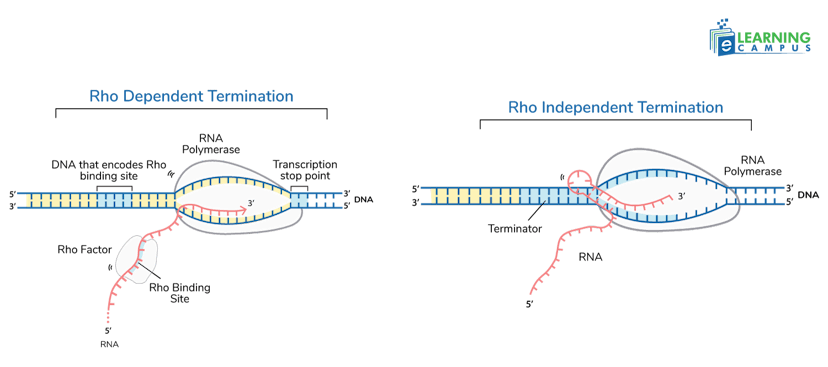
The product of transcription is a single-stranded RNA molecule, which can be messenger RNA (mRNA), transfer RNA (tRNA), or ribosomal RNA (rRNA), depending on the gene transcribed.
Transcription is tightly regulated to ensure that only the necessary genes are expressed at the right time and in the right cells.
Types of RNA and Structural Variations
There are three main types of RNA that include messenger RNA (mRNA), transfer RNA (tRNA), and ribosomal RNA (rRNA). Different RNA types have distinct structures according to their functions.
Messenger RNA (mRNA)
A messenger RNA carries genetic information from DNA in the nucleus to the ribosomes in the cytoplasm. It acts as a blueprint, providing the coded instructions for building a protein.
Structure of Messenger RNA
mRNA is a single-stranded molecule that is composed of a chain of ribonucleotides (adenine, cytosine, guanine, and uracil). It has a sugar-phosphate backbone.
Its structure is mostly linear, with a 5’ cap (modified guanine) and a 3’ poly-A tail for stability and translation. This RNA contains exons (coding sequences) and introns (non-coding regions). In eukaryotes, introns are removed and exons are joined through a process called splicing.
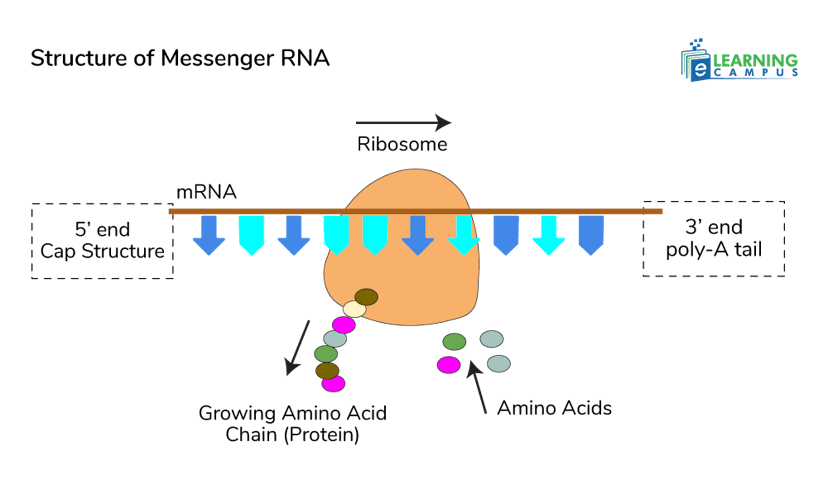
Transfer RNA (tRNA)
Transfer RNA (tRNA) plays an important role in protein synthesis. It acts as an adapter to bring specific amino acids to the ribosome, where they are linked together to form proteins.
Structure of Transfer RNA (tRNA)
tRNA has an L-shaped three-dimensional structure derived from a two-dimensional cloverleaf secondary structure. It is characterized by a D-arm, an anticodon arm, and a T-arm.
Each tRNA has an anticodon loop that matches a specific mRNA codon and an amino acid attachment site at its opposite end. It helps in delivering the correct amino acid to the growing protein chain according to the genetic code.
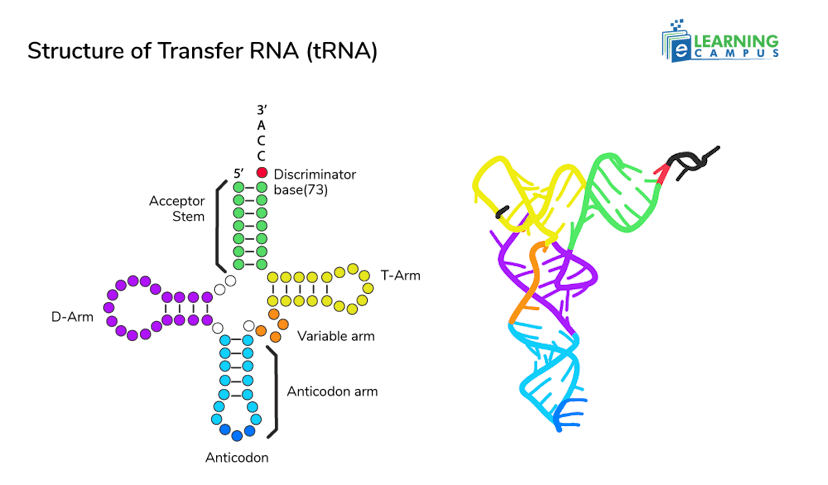
Ribosomal RNA (rRNA)
Ribosomal RNA plays both structural and catalytic roles in protein synthesis.
It self-assembles with ribosomal proteins to form two subunits (a large and a small), which make up the complete ribosome.
Structure of Ribosomal RNA (rRNA)
Ribosomal RNA (rRNA) consists of complex three-dimensional structures. The rRNA folds into double-stranded segments called helices. It is interspersed with single-stranded regions and forms complex shapes to bind to mRNA and link amino acids.
Ribosomes, made of two subunits (a large and a small one), contain different rRNA molecules, such as 18S, 28S, 5.8S, and 5S in eukaryotes and 16S, 23S, and 5S in prokaryotes.
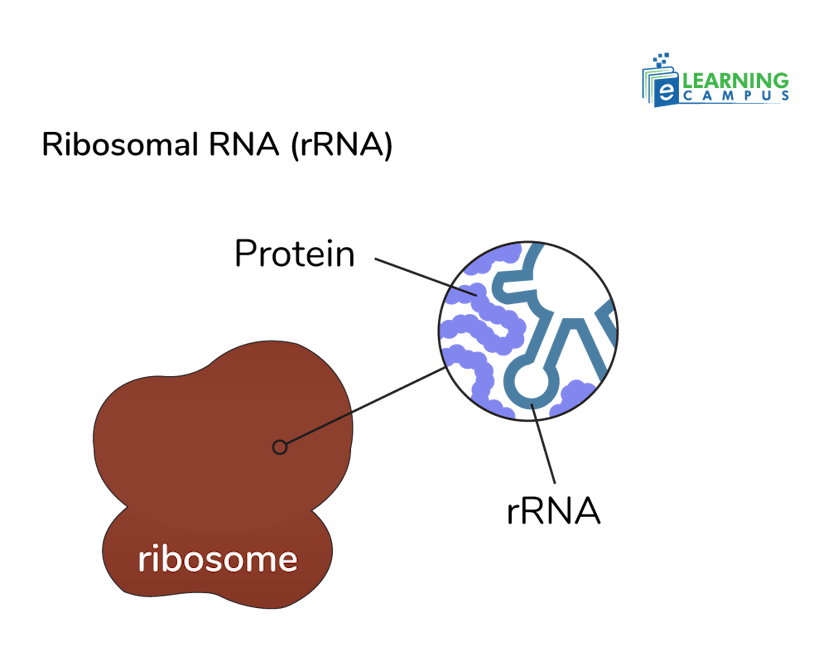
Other Types of RNA– Noncoding
Beyond protein synthesis, various non-coding RNAs perform other important functions, including the regulation of gene expression. Here are some of the other types of RNA.
- Small nuclear RNA (snRNA): These are found in the nucleus and are involved in splicing processes. These snRNPs combine to create the spliceosome, a complex responsible for removing introns from messenger RNA, or mRNA.
- MicroRNA (miRNA): These small non-coding RNAs regulate gene expression by binding to messenger RNAs.
- Long Non-Coding RNA (lncRNA): A diverse class of RNA molecules that do not code for proteins but play roles in gene regulation.
- Small Nucleolar RNA (snoRNA): It is found in the nucleolus. These RNAs are involved in chemical modifications of other RNA molecules.
RNA Structure Prediction
RNA structure prediction is the method to determine the three-dimensional structure of an RNA molecule from its nucleotide sequence.
The traditional methods of prediction rely on free energy minimization and thermodynamic principles to predict the secondary structure of RNA.
The new methods use computational methods involving machine learning and deep learning. It incorporates experimental data and AI to achieve higher accuracy for tertiary structures of RNA.
DNA vs RNA Structure- Similarities and Differences
Both DNA and RNA are forms of genetic material, but they serve different roles in living organisms. DNA is the primary genetic material that holds the fundamental blueprint of life.
On the other hand, RNA is essential for carrying out the instructions encoded in DNA to build proteins. It also serves as the genetic material for certain viruses.
The DNA and RNA have several similarities and differences based on their structure and functions.
Structural Similarities Between DNA and RNA
- Both are polymers. It means they are made of repeating units called nucleotides.
- Each nucleotide has a phosphate group and a five-carbon sugar (a pentose).
- Both molecules contain three of the same nitrogenous bases: adenine (A), cytosine (C), and guanine (G).
- Adenine pairs with thymine (in DNA) or uracil (in RNA), and guanine always pairs with cytosine.
Structural Differences Between RNA and DNA
- DNA contains deoxyribose sugar, while RNA contains ribose sugar. The ribose sugar has an extra hydroxyl group, making RNA less stable.
- DNA contains the base thymine (T), whereas RNA uses uracil (U) in place of thymine.
- DNA is a double-stranded molecule that forms a stable double helix. RNA is a single-stranded molecule.
- The double-stranded DNA structure is more stable and suitable for long-term storage of genetic information. The single-stranded, more flexible RNA molecule is less stable and more reactive, allowing it to fold into complex shapes for various functions.
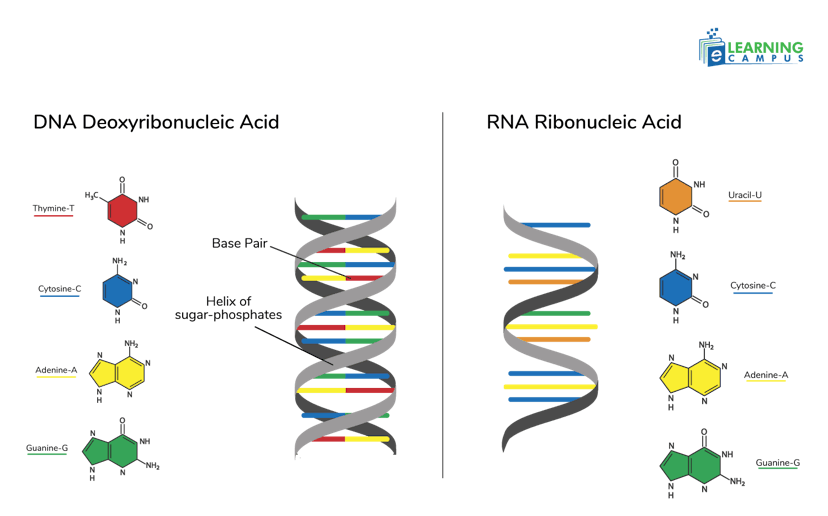
Conclusion
RNA is a single-stranded nucleic acid made of nucleotides. Each nucleotide contains a ribose sugar, a phosphate group, and one of four bases: adenine (A), cytosine (C), guanine (G), or uracil (U). Key differences from DNA include the sugar (ribose instead of deoxyribose), the base uracil (replacing thymine), and its typically single-stranded nature.
Get Expert Online Tutoring For Science
Are you struggling with science subjects and don’t know how to prepare for your exams? We are at your service. We have professional online science tutors to help you learn science through a structured approach. You will get individualized instruction and targeted preparation for your exams.
